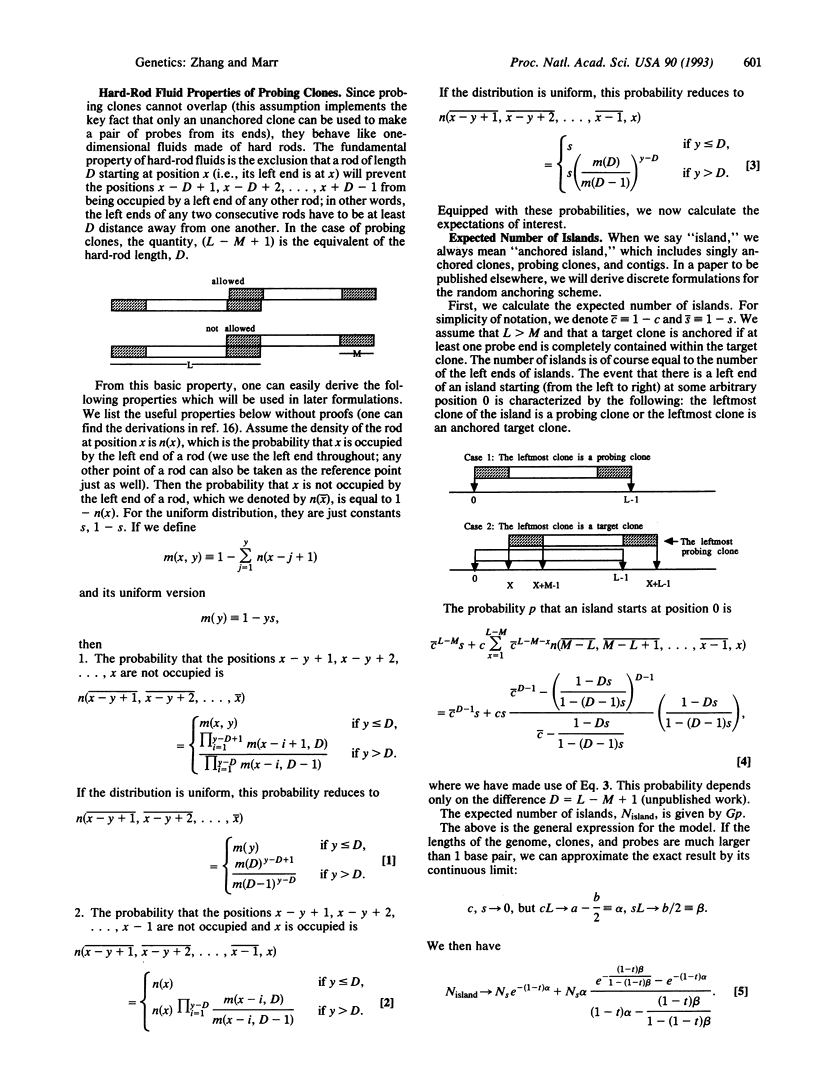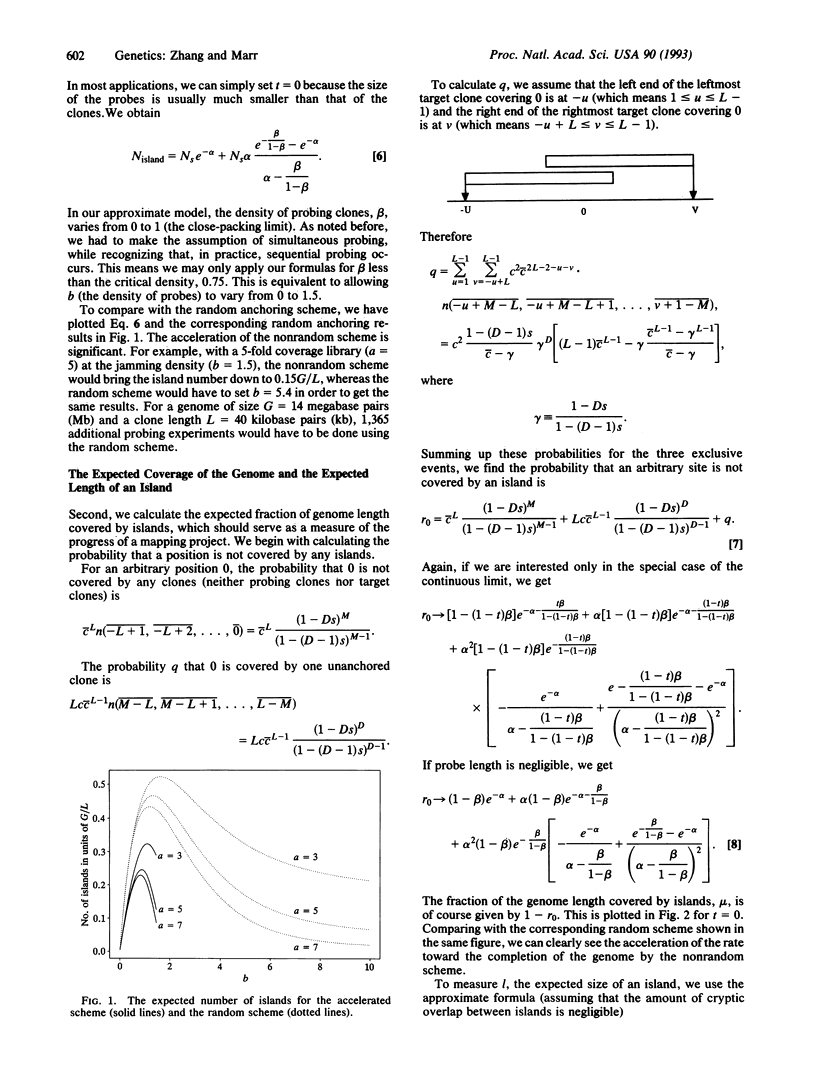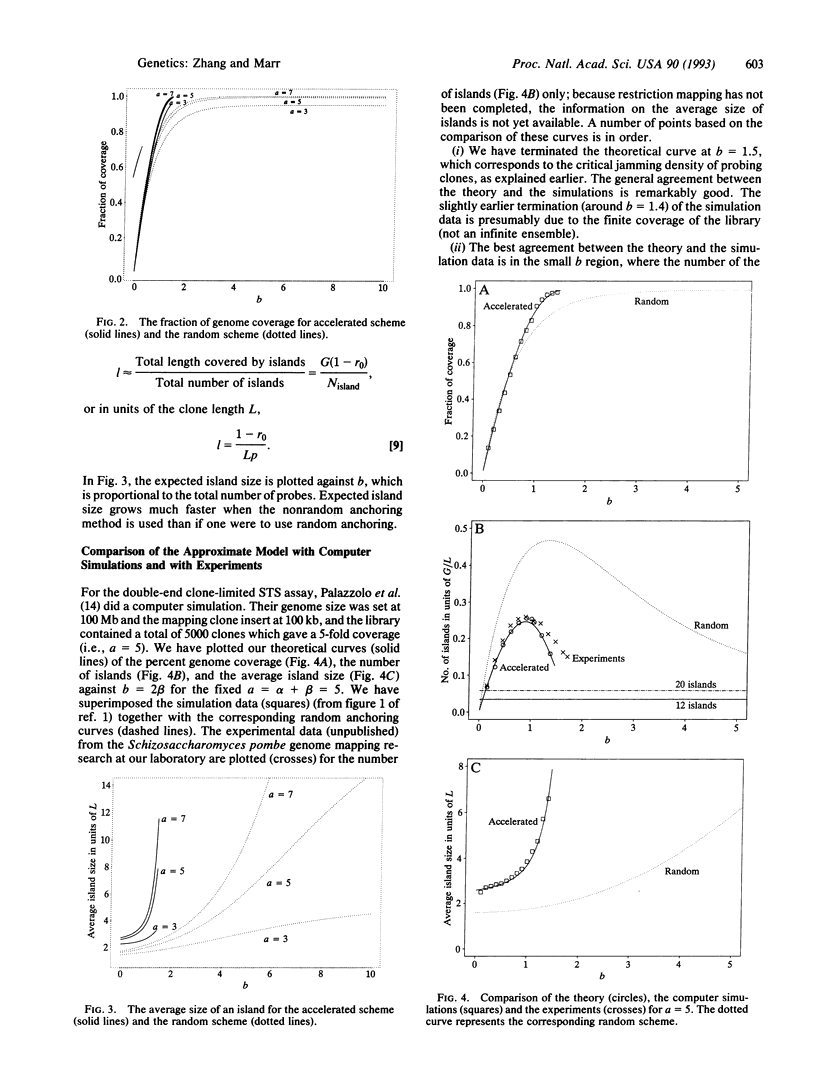Abstract
As part of our effort to construct a physical map of the genome of the fission yeast Schizosaccharomyces pombe, we have made theoretical predictions for the progress expected, as measured by the expected length fraction of island coverage and by the expected properties of the anchored islands such as the number and the size of islands. Our experimental strategy is to construct a random clone library and screen the library for clones having unique sequence at both ends. This scheme is essentially the same as the clone-limited double sequence-tagged-site selection scheme which was used in a computer simulation by Palazzolo et al. [Palazzolo, M. J., Sawyer, S. A., Martin, C. H., Smoller, D. A. & Hartl, D. L. (1991) Proc. Natl. Acad. Sci. USA 88, 8034-8038]. Both simulation and ongoing experiments in our laboratory have shown that the nonrandom anchoring method is far superior to random anchoring. In this paper, we propose a theoretical model to explain the simulated data and the experimental data.
Full text
PDF




Selected References
These references are in PubMed. This may not be the complete list of references from this article.
- Arratia R., Lander E. S., Tavaré S., Waterman M. S. Genomic mapping by anchoring random clones: a mathematical analysis. Genomics. 1991 Dec;11(4):806–827. doi: 10.1016/0888-7543(91)90004-x. [DOI] [PubMed] [Google Scholar]
- Barillot E., Dausset J., Cohen D. Theoretical analysis of a physical mapping strategy using random single-copy landmarks. Proc Natl Acad Sci U S A. 1991 May 1;88(9):3917–3921. doi: 10.1073/pnas.88.9.3917. [DOI] [PMC free article] [PubMed] [Google Scholar]
- Coulson A., Sulston J., Brenner S., Karn J. Toward a physical map of the genome of the nematode Caenorhabditis elegans. Proc Natl Acad Sci U S A. 1986 Oct;83(20):7821–7825. doi: 10.1073/pnas.83.20.7821. [DOI] [PMC free article] [PubMed] [Google Scholar]
- Evans G. A., Lewis K., Rothenberg B. E. High efficiency vectors for cosmid microcloning and genomic analysis. Gene. 1989 Jun 30;79(1):9–20. doi: 10.1016/0378-1119(89)90088-7. [DOI] [PubMed] [Google Scholar]
- Ewens W. J., Bell C. J., Donnelly P. J., Dunn P., Matallana E., Ecker J. R. Genome mapping with anchored clones: theoretical aspects. Genomics. 1991 Dec;11(4):799–805. doi: 10.1016/0888-7543(91)90003-w. [DOI] [PubMed] [Google Scholar]
- Green E. D., Olson M. V. Chromosomal region of the cystic fibrosis gene in yeast artificial chromosomes: a model for human genome mapping. Science. 1990 Oct 5;250(4977):94–98. doi: 10.1126/science.2218515. [DOI] [PubMed] [Google Scholar]
- Kohara Y., Akiyama K., Isono K. The physical map of the whole E. coli chromosome: application of a new strategy for rapid analysis and sorting of a large genomic library. Cell. 1987 Jul 31;50(3):495–508. doi: 10.1016/0092-8674(87)90503-4. [DOI] [PubMed] [Google Scholar]
- Lander E. S., Waterman M. S. Genomic mapping by fingerprinting random clones: a mathematical analysis. Genomics. 1988 Apr;2(3):231–239. doi: 10.1016/0888-7543(88)90007-9. [DOI] [PubMed] [Google Scholar]
- Olson M. V., Dutchik J. E., Graham M. Y., Brodeur G. M., Helms C., Frank M., MacCollin M., Scheinman R., Frank T. Random-clone strategy for genomic restriction mapping in yeast. Proc Natl Acad Sci U S A. 1986 Oct;83(20):7826–7830. doi: 10.1073/pnas.83.20.7826. [DOI] [PMC free article] [PubMed] [Google Scholar]
- Palazzolo M. J., Sawyer S. A., Martin C. H., Smoller D. A., Hartl D. L. Optimized strategies for sequence-tagged-site selection in genome mapping. Proc Natl Acad Sci U S A. 1991 Sep 15;88(18):8034–8038. doi: 10.1073/pnas.88.18.8034. [DOI] [PMC free article] [PubMed] [Google Scholar]
- Stallings R. L., Torney D. C., Hildebrand C. E., Longmire J. L., Deaven L. L., Jett J. H., Doggett N. A., Moyzis R. K. Physical mapping of human chromosomes by repetitive sequence fingerprinting. Proc Natl Acad Sci U S A. 1990 Aug;87(16):6218–6222. doi: 10.1073/pnas.87.16.6218. [DOI] [PMC free article] [PubMed] [Google Scholar]
- Torney D. C. Mapping using unique sequences. J Mol Biol. 1991 Jan 20;217(2):259–264. doi: 10.1016/0022-2836(91)90540-m. [DOI] [PubMed] [Google Scholar]
- Welsh J., McClelland M. Fingerprinting genomes using PCR with arbitrary primers. Nucleic Acids Res. 1990 Dec 25;18(24):7213–7218. doi: 10.1093/nar/18.24.7213. [DOI] [PMC free article] [PubMed] [Google Scholar]
- Williams J. G., Kubelik A. R., Livak K. J., Rafalski J. A., Tingey S. V. DNA polymorphisms amplified by arbitrary primers are useful as genetic markers. Nucleic Acids Res. 1990 Nov 25;18(22):6531–6535. doi: 10.1093/nar/18.22.6531. [DOI] [PMC free article] [PubMed] [Google Scholar]


